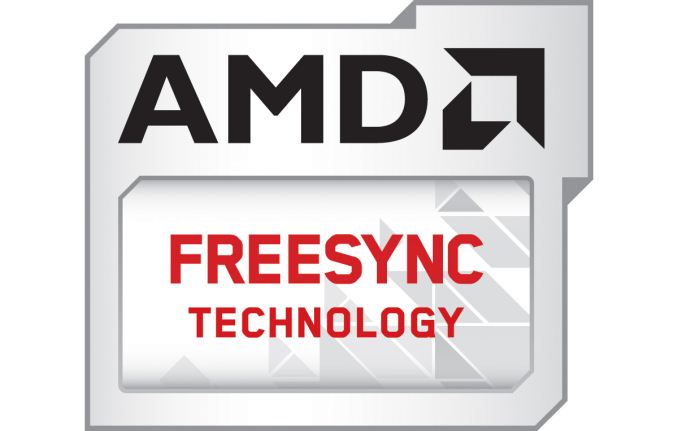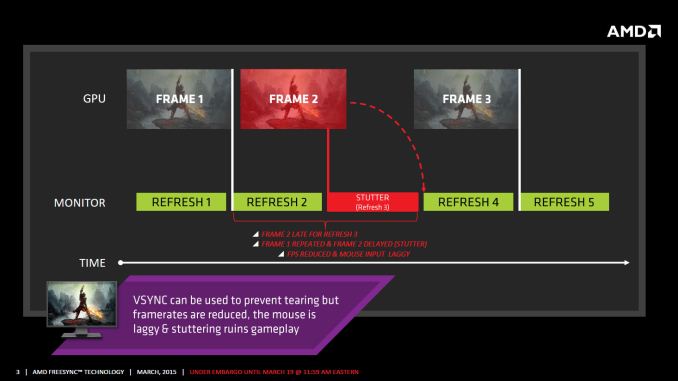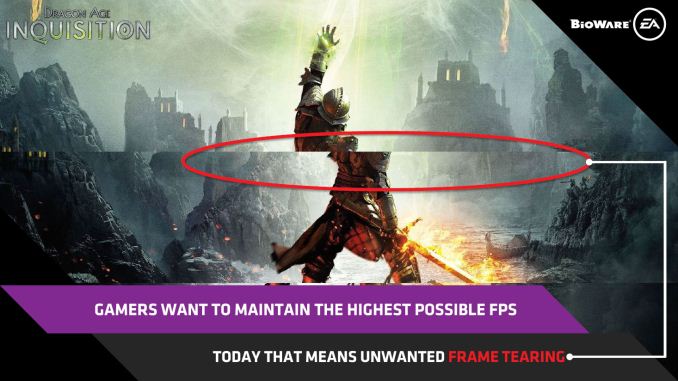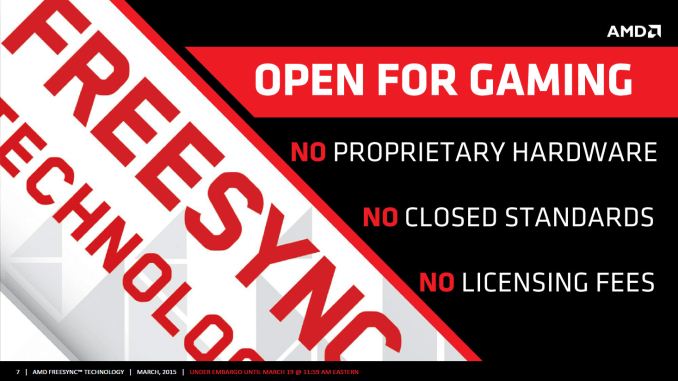The AMD FreeSync Review
by Jarred Walton on March 19, 2015 12:00 PM EST
Introduction to FreeSync and Adaptive Sync
The first time anyone talked about adaptive refresh rates for monitors – specifically applying the technique to gaming – was when NVIDIA demoed G-SYNC back in October 2013. The idea seemed so logical that I had to wonder why no one had tried to do it before. Certainly there are hurdles to overcome, e.g. what to do when the frame rate is too low, or too high; getting a panel that can handle adaptive refresh rates; supporting the feature in the graphics drivers. Still, it was an idea that made a lot of sense.
The impetus behind adaptive refresh is to overcome visual artifacts and stutter cause by the normal way of updating the screen. Briefly, the display is updated with new content from the graphics card at set intervals, typically 60 times per second. While that’s fine for normal applications, when it comes to games there are often cases where a new frame isn’t ready in time, causing a stall or stutter in rendering. Alternatively, the screen can be updated as soon as a new frame is ready, but that often results in tearing – where one part of the screen has the previous frame on top and the bottom part has the next frame (or frames in some cases).
Neither input lag/stutter nor image tearing are desirable, so NVIDIA set about creating a solution: G-SYNC. Perhaps the most difficult aspect for NVIDIA wasn’t creating the core technology but rather getting display partners to create and sell what would ultimately be a niche product – G-SYNC requires an NVIDIA GPU, so that rules out a large chunk of the market. Not surprisingly, the result was that G-SYNC took a bit of time to reach the market as a mature solution, with the first displays that supported the feature requiring modification by the end user.
Over the past year we’ve seen more G-SYNC displays ship that no longer require user modification, which is great, but pricing of the displays so far has been quite high. At present the least expensive G-SYNC displays are 1080p144 models that start at $450; similar displays without G-SYNC cost about $200 less. Higher spec displays like the 1440p144 ASUS ROG Swift cost $759 compared to other WQHD displays (albeit not 120/144Hz capable) that start at less than $400. And finally, 4Kp60 displays without G-SYNC cost $400-$500 whereas the 4Kp60 Acer XB280HK will set you back $750.
When AMD demonstrated their alternative adaptive refresh rate technology and cleverly called it FreeSync, it was a clear jab at the added cost of G-SYNC displays. As with G-SYNC, it has taken some time from the initial announcement to actual shipping hardware, but AMD has worked with the VESA group to implement FreeSync as an open standard that’s now part of DisplayPort 1.2a, and they aren’t getting any royalties from the technology. That’s the “Free” part of FreeSync, and while it doesn’t necessarily guarantee that FreeSync enabled displays will cost the same as non-FreeSync displays, the initial pricing looks quite promising.
There may be some additional costs associated with making a FreeSync display, though mostly these costs come in the way of using higher quality components. The major scaler companies – Realtek, Novatek, and MStar – have all built FreeSync (DisplayPort Adaptive Sync) into their latest products, and since most displays require a scaler anyway there’s no significant price increase. But if you compare a FreeSync 1440p144 display to a “normal” 1440p60 display of similar quality, the support for higher refresh rates inherently increases the price. So let’s look at what’s officially announced right now before we continue.













350 Comments
View All Comments
chizow - Thursday, March 19, 2015 - link
See link: http://www.pcper.com/image/view/54234?return=node%...Also: still unaddressed concerns with how and why FreeSync is still tied to Vsync and how this impacts latency.
happycamperjack - Thursday, March 19, 2015 - link
The ghosting problem actually has nothing to do with the G-Sync and FreeSync technologies like the article said, but more have to do with the components in the monitor. So if Asus made a ROG Swift FreeSync version of the same monitor, there would've been no ghosting just like the G-SYNC version. So your example is invalid.chizow - Friday, March 20, 2015 - link
@happycamperjack. Again, incorrect. Why is it that panels from the SAME manufacturers, that possibly use the same panels even, using the same prevaling panel technologies of this time, exhibit widely different characteristics under variable refresh? Maybe that magic G-Sync module that AMD claims is pointless is actually doing something....like controlling the drive electronics that control pixel response variably in response to changing framerates. Maybe AMD needs another 18 months to refine those scalers with the various scaler mfgs?http://www.pcper.com/reviews/Displays/AMD-FreeSync...
"Modern monitors are often tuned to a specific refresh rate – 144 Hz, 120 Hz, 60 Hz, etc. – and the power delivery to pixels is built to reduce ghosting and image defects. But in a situation where the refresh rate can literally be ANY rate, as we get with VRR displays, the LCD will very often be in these non-tuned refresh rates. NVIDIA claims its G-Sync module is tuned for each display to prevent ghosting by change the amount of voltage going to pixels at different refresh rates, allowing pixels to untwist and retwist at different rates."
BenQ for example makes a fine G-Sync monitor, and multiple high refresh 3D Vision monitors well known for their lack of ghosting. Are you going to tell me that suddenly they are using inferior panel tech that can't handle ghosting? This is 2015 and TN panels we are talking about here right? This kind of ghosting has not been seen since circa 2007 when PMVA was all the rage.
AnnihilatorX - Thursday, March 19, 2015 - link
chizow stop your biased preconceptions and actually read the articleAnnihilatorX - Thursday, March 19, 2015 - link
I will summarize it for you in case your prejudice clouds your comprehension1) At no point in the article it finds any performance advantage from FreeSync or Gsync (AMD claims 0.5-1% advantage but that's too small to detect, so we disregard that)
2) Freesync has better monitor choices, including IPS and ones with better specs in general
3) Freesync monitors are about USD200 cheaper, almost half the cost of a decent graphic card
4) Freesync monitors have on-screen dialogues (OSD) that works, Gsync monitor doesn't due to implementation
5) Freesync has better potential in future for support, especially laptops becuase of zero royalty fees and only minor update to hardware
6. Freesync allows users the option to choose whether they want to enable Vsync or not, Gsync locks Vsync to be on. This mean the user can have better latency if they can stand tearing. The important thing is option, having the option is always advantageous
7. AMD claims Freesync works from 9Hz-240Hz wheras Gsync only works from 30Hz to 144Hz.
chizow - Thursday, March 19, 2015 - link
@AnnihilatorX1) You assume the tests conducted here are actually relevant.
2) No, they don't. Nvidia has an IPS in the works that may very well be the best of all, but in the meantime, it is obvious that for whatever reason the FreeSync panels are subpar compared to the G-Sync offerings. Coutesy of PCPER: http://www.pcper.com/image/view/54234?return=node%...
3) Sure they are cheaper, but they also aren't as good, and certainly not "Free" as there is a clear premium compared to non-FreeSync panels, and certainly no firmware flash is going to change that. Also, that $200 is going to have to be spent on a new AMD graphics GCN1.1+ graphics card anyways as anyone who doesn't already own a newer AMD card will have to factor that into their decision. Meanwhile, G-Sync supports everything from Nvidia from Kepler on. Nice and tidy (and dominant in terms of installed user base).
4) OSDs, scalers and such add input lag, while having multiple inputs is nice, OSDs are a feature gaming purists can live without (See: all the gaming direct input modes on newer LCDs that bypass the scalers).
5) Not if they're tied to AMD hardware. They can enjoy a minor share of the dGPU graphics market as their TAM.
6) Uh, this is nonsense. FreeSync is still tied to Vsync in ways THIS review certainly doesn't cover indepth, but that's certainly not going to be a positive since Vsync inherently adds latency. Meanwhile, Vsync is never enabled with G-Sync, and while there is more latency at the capped FPS, it is a driver-side cap and not Vsync enabled.
7) Well, AMD can claim all they like it goes as low as 9Hz but as we have seen the implementation is FAR worst, falling apart below 40FPS where blurring, tearing, basically the image falls apart and everything you invested hundreds of dollars basically became a huge waste. Meanwhile, G-Sync shows none of these issues, and I play some MMOs that regularly dip into the 20s in crowded cities, no sign of any of this.
So yes, as I've shown, there are still many issues with FreeSync that need to be addressed that show it is clearly not as good as G-Sync. But like I said, this is a good introduction to the tech that Nvidia invented some 18 months ago, maybe with another 18 months AMD will make more refinements and close the gap?
lordken - Thursday, March 19, 2015 - link
5) what? Where did you got that Adaptive sync is tied to AMD HW? Thats pretty bullshit, if it would then it wouldnt be standardized by VESA right?If today it is only AMD HW that can support it (cause they implement first) doesnt validate your claim that it is AMD tied. Intel/nvidia/... can implement it in their products if they want.
It is like you would be saying that if for example LG release first monitor that will support DP1.3 that it implies DP1.3 is LG tied lol
On other hand Gsync is Nvidia tied. But you know this right?
chizow - Thursday, March 19, 2015 - link
@lordken, who else supports FreeSync? No one but AMD. Those monitor makers can ONLY expect to get business from a minor share of the graphics market given that is going to be the primary factor in paying the premium for one over a non-FreeSync monitor. This is a fact.anubis44 - Tuesday, March 24, 2015 - link
VESA supports FreeSync, which means Intel will probably support it, too. Intel graphics drive far more computers than AMD or nVidia, which means that if Intel does support it, nVidia is euchred, and even if Intel doesn't support it, many more gamers will choose free over paying an extra $150-$200 for a gaming setup. Between the 390-series coming out shortly and the almost guaranteed certainty that some hacked nVidia drivers will show up on the web to support FreeSync, G-Sync is a doomed technology. Period.chizow - Tuesday, March 24, 2015 - link
Intel has no reason to support FreeSync, and they have shown no interest either. Hell they showed more interest in Mantle but as we all know, AMD denied them (so much for being the open hands across the globe company).But yes I'm hoping Nvidia does support Adaptive Sync as their low-end solution and keeps G-Sync as their premium solution. As we have seen, FreeSync just isn't good enough but at the very least it means people will have even less reason to buy AMD if Nvidia supports both lower-end Adaptive Sync and premium G-Sync monitors.